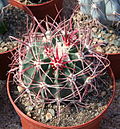Echinocactus
| Echinocactus | |
|---|---|

| |
| Echinocactus grusonii | |
| Scientific classification | |
| Kingdom: | Plantae |
| Clade: | Tracheophytes |
| Clade: | Angiosperms |
| Clade: | Eudicots |
| Order: | Caryophyllales |
| Family: | Cactaceae |
| Subfamily: | Cactoideae |
| Tribe: | Cacteae |
| Genus: | Echinocactus Link & Otto[1] |
| Type species | |
| Echinocactus platyacanthus | |
| Species | |
|
See text | |
| Synonyms | |
|
Brittonrosea Speg. | |
Echinocactus is a genus of cacti in the subfamily Cactoideae.[1] The generic name derives from the Ancient Greek εχινος (echinos), meaning "spiny," and cactus. It and Ferocactus are the two genera of barrel cactus. Members of the genus usually have heavy spination and relatively small flowers. The fruits are copiously woolly, and this is one major distinction between Echinocactus and Ferocactus. Propagation is by seed.
Perhaps the best known species is the golden barrel (Echinocactus grusonii) from Mexico, an easy-to-grow and widely cultivated plant. Though common in the houseplant and landscape industry, the golden barrel has become very rare in habitat.
Species
As of 2020, the genus includes 6 accepted species out of hundreds of plants having the name.[2]
| Image | Scientific name | Common Name | Distribution |
|---|---|---|---|
 |
Echinocactus grusonii Hildm. | Golden Barrel Cactus | Querétaro, and in the state of Hidalgo, Mexico |
 |
Echinocactus horizonthalonius Lem. | Devil's Head, Silverbell Cactus, Turk's Head CactusGolden Barrel Cactus | southwestern United States and northern Mexico |
 |
Echinocactus parryi Engelm., 1856 | horse crippler or devil's pincushion | Mexican state of Chihuahua |
 |
Echinocactus platyacanthus Link & Otto | Giant Barrel Cactus | Mexico in the Chihuahuan Desert |
 |
Echinocactus polycephalus Engelm. & J.M.Bigelow | Cottontop Cactus | Mojave Desert region of Arizona, California, and Nevada, and northern Sonora, Mexico. |
 |
Echinocactus texensis Hopffer | Horse Crippler, Devil's Pincushion[3][4] | United States and Mexico. |
Formerly placed here
- Astrophytum asterias (Zucc.) Lem. (as E. asterias Zucc.)
- Aztekium ritteri (Boed.) Boed. (as E. ritteri Boed.)
- Ferocactus wislizeni (Engelm.) Britton & Rose (as E. wislizeni Engelm.)
- Lophophora williamsii (Lem. ex Salm-Dyck) J.M.Coult. (as E. williamsii Lem. ex Salm-Dyck)
- Turbinicarpus subterraneus (Backeb.) A.D.Zimm. (as E. subterraneus Backeb.)[3]
References
- ^ a b c "Genus: Echinocactus Link & Otto". Germplasm Resources Information Network. United States Department of Agriculture. 2004-02-13. Archived from the original on 2012-10-09. Retrieved 2010-11-13.
- ^ "Echinocactus". The Plant List. Royal Botanic Gardens, Kew. Note that this website has been superseded by World Flora Online
- ^ a b "GRIN Species Records of Echinocactus". Germplasm Resources Information Network. United States Department of Agriculture. Archived from the original on 2012-12-12. Retrieved 2010-11-13.
- ^ "Echinocactus". Integrated Taxonomic Information System. Retrieved 2010-11-13.
- Innes C, Wall B (1995). Cacti, Succulents and Bromeliads. Cassell & The Royal Horticultural Society.
